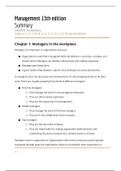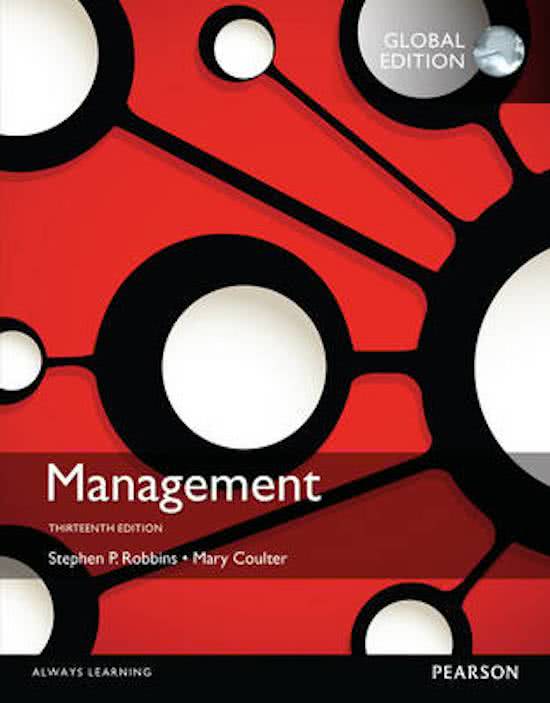Management 13th edition
Summary
CREATED BY: Amy Wezenberg
Chapters 1, 2, 3, 4, 7, 8, 9, 10, 11, 12, 13, 15, 16, 17, 18 + All important definitions
Chapter 1: Managers in the workplace
Managers are important to organizations because:
● Organizations need their managerial skills and abilities in uncertain, complex, and
chaotic times. Managers can identify critical issues and crafting responses.
● Managers get things done.
● A good relationship between superior and employee increases productivity
A manager’s job is not about personal achievement, it’s about helping others to do their
work. There are roughly speaking three kinds of different managers:
● First-line managers
○ They manage the work of nonmanagerial employees
○ They are often named supervisors
○ They are the lowest level of management
● Middle managers
○ They manage the work of first-line managers
○ They are in the middle level of the company
● Top managers
○ They are the top of the company
○ They are responsible for making organization-wide decisions and
establishing the plans and goals the company wants to achieve
Managers work in organizations. Organizations often have a distinct purpose typically
expressed through goals the organization hopes to accomplish. Each organization is
1
,composed of people. Organizations develop a structure where employees do their job.
Management is simply speaking coordinating and overseeing the work activities of others
so their activities are completed efficiently and effectively. Managers strive for the
maximum possible efficiency of the available scarce resources, such as labor and for
effectiveness, doing certain work activities that lead to accomplishing a set goal. There are
four functions used to describe managers’ work. If the following functions are met, they
lead to achieving the organization’s stated purpose:
● Planning
○ Setting goals, establishing strategies and developing plans to coordinate
activities
● Organizing
○ Determining what needs to be done, how it will be done, and who is to do it
● Leading
○ Motivating, leading, and any other actions involved in dealing with people
● Controlling
○ Monitoring activities to ensure that they are accomplished as planned
Henry Mintzberg, a well-known management researcher, concluded there are different
managerial roles:
● Interpersonal roles involve people
○ Figurehead, leader, liaison.
● Informal roles involve collecting, receiving and disseminating information
○ Monitor, disseminator, spokesperson
● decisional roles entail making decisions or choices
○ Negotiator, resource allocator, disturbance handler, entrepreneur
Managers need three critical skills in managing.
● Technical skills
2
, ○ The job-specific knowledge, most important for first-line managers
● Interpersonal skills
○ The ability to work well with other people, equally important for everyone
● Conceptual skills
○ The ability to think and conceptualize about complex/abstract situations
Definitions:
Manager: Someone who coordinates and oversees the work of other people so
organizational goals can be accomplished.
First-line (frontline) managers: Management at the lowest level of management who
manage the work of nonmanagerial employees
Middle managers: Managers between the lowest level and top levels of the organization
who manage the work of first-line managers
Top managers: Managers at or near the upper levels of the organization structure who are
responsible for making organization-wide decisions and establishing the goals and plans
that affect the entire organization.
Organization: A deliberate management of people to accomplish some specific purpose
Management: Coordinating and overseeing the work activities of others so their activities
are completed efficiently and effectively
Efficiency: Doing things right, or getting the most output from the least amount of inputs
Effectiveness: Doing the right things, or doing those work activities that will result in
achieving goals
Interpersonal roles: Managerial roles that involve people and other duties that are
ceremonial and symbolic in nature
Informational roles: Managerial roles that involve collecting, receiving and disseminating
3
,information
Decisional roles: Managerial roles that revolve around making choices
Chapter 2: Making decisions
Managers at all levels and in all areas of organizations make decisions. The decisionmaking
process consists of eight steps:
1. Identifying a Problem.
2. Identify Decision Criteria.
3. Allocate weights to the Criteria
4. Develop Alternatives
5. Analyze Alternatives
6. Select an Alternative
7. Implement the Alternative
8. Evaluate Decision Effectiveness
We assume managers will use rational decision making. A rational decision-maker would
be fully objective and logical, however, for managerial decision making one has to assume
a manager takes decisions that are best for the company and that are thus not always
rational. A more realistic approach to how managers make decisions is the concept of
bounded rationality, which means managers are bounded by their ability to process
information.
Most managers don’t make perfectly rational decisions, so they satisfice, they don’t
maximize. Their decision making is influenced by a number of influences, one being the
escalation of commitment, an increased commitment to a previous decision despite
evidence that was wrong. Most people don’t want to admit it might have been wrong.
Managers often use intuition to make decisions. There are five types of intuitive decision
making, Experience-based decisions, Affect-initiated decisions, Cognitive-based decisions,
Subconscious mental processing, and Values or ethics-based decisions.
4
, Some problems are easy, they’re structured problems. Managers can respond with a
programmed decision, one that they make using their routine approach. They use
procedures or policies to deal with the issue.
Not all decisions are easy, there are also unstructured problems, these are new or unusual
problems. Managers cannot rely on programmed decisions, they must make
unprogrammed decisions. They use judgment, creativity, and skill to solve them.
The ideal conditions for making decisions is one of certainty, a situation where a manager
knows the outcome of every alternative and can make the best one. A far more common
situation is a risk, where a manager estimates the likelihood of certain outcomes. If a
manager has to make a decision in uncertainty, neither certainty or the risk is known. A
manager will then often apply either the Maximin, Maximax or Laplace (PABU06!) method to
decide which alternative is best.
Managers have two different main styles of thinking, linear thinking, and non-linear
thinking. Linear thinking tends to be more logical and rational and fact-based, non-linear
thinkers rely more on their intuition.
Managers often make twelve common decision errors based on biases they may have,
these are Overconfidence, Immediate Gratification, Anchoring Effect, Selective Perception,
Conformation, Framing, Availability, Representation, Randomness, Sunk Costs, Self-serving and
Hindsight.
Definitions:
Decision: A choice among two or more alternatives
Problem: An obstacle that makes it difficult to achieve a desired goal or purpose
Decision criteria: Criteria that define what’s important or relevant to resolving a problem
Rational Decision Making: Describes choices that are logical and consistent and maximize
value.
5





